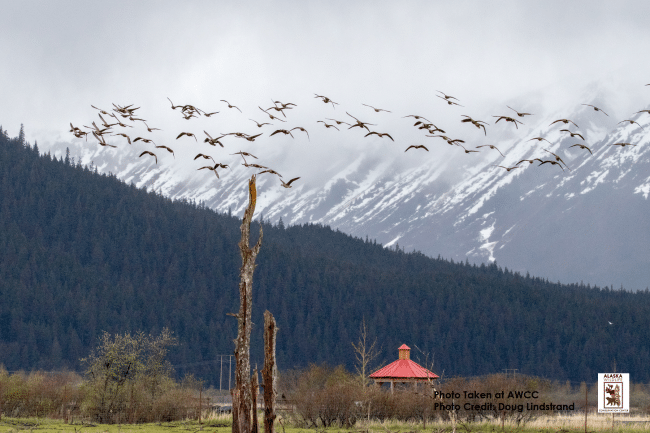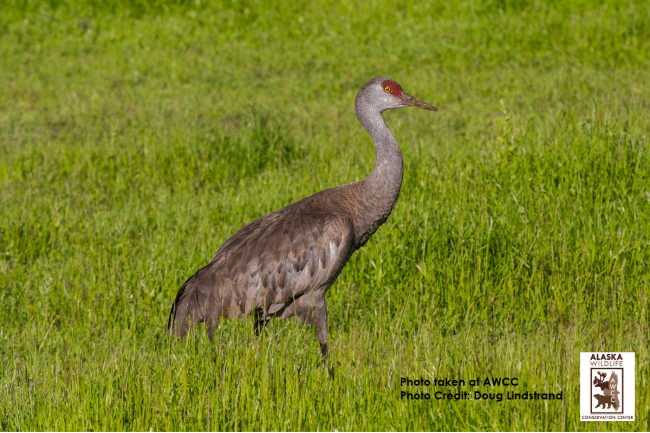
A flock of geese fly over the gazebo at the Alaska Wildlife Conservation Center
By Duane Magoon and Lily Grbavach
The southbound fall migration of our winged, feathered friends has begun. Thousands of birds pass through Turnagain Arm and Portage Valley on their way to warmer climates. These birds flew north to Alaska in Spring in pursuit of the abundance of food and available habitat. Many of them have reproduced and raised offspring. Now, as we start to feel frost in the air when we wake up and notice a sprinkle of termination dust on the mountains surrounding us, these birds are ready to fly south. Birds that have spent the plentiful summer with us in Alaska will migrate across Canada, the Lower 48, and beyond through all four of the flyways that span the length of the Americas.
The Alaska Wildlife Conservation Center (AWCC) is nestled into a landscape of transition. Bound on one side by the Pacific Ocean where it sneaks up Turnagain Arm, AWCC looks out onto Portage Valley, a gateway to Prince William Sound and is bordered by dusty peaks and receding glaciers. In the skies above us and stopping over to rest in our ponds and fields migratory birds are largely on two global flyways. The Pacific Flyway, which will take these feathered travelers down the panhandle of Alaska and British Columbia, through the Pacific North West, on to California, and for some even further. Otherwise, The East Asia-Australia Flyway will have flocks taking the long restless route over the Pacific Ocean. Making AWCC a wonderful place to observe this parade of wildlife.

A sandhill crane at the Alaska Wildland Conservation Center near Portage, Alaska
A combination of strong seasonal storms and high tides can partially flood fields at the AWCC which draws the attention of fowl needing a safe sanctuary stopover on their way south. With the number of birds known to be stopping here and the accessibility of our location, AWCC has been listed as a birding hotspot on Cornell University’s eBird website and app. The eBird platform provides an opportunity for community scientists, avid birders and amateurs alike to share their bird observations with a wide audience. This breadth of data available through eBird because of these observations is accessible to many. This data can help other birders identify the best times of year and places to make the sightings they have hoped for or help them spot the most elusive of birds. These data are also used by scientists who are publishing new findings, making wildlife conservation decisions, or even learning through undergraduate research. Every observation recorded at AWCC and across the globe contributes to this.
We are using these data to learn more about the birds we can expect to see at AWCC and making that information accessible to guests. Through accessing data available on eBird we learned that forty-one species were recorded passing through AWCC in August 2020. We also learned that we have people returning to our hotspot of a location to observe birds who are submitting data. Some notable species that were spotted at AWCC over the past year include: trumpeter swans, lesser sandhill cranes, golden plovers, merlins, peregrine falcons and more. During this fall migration we hope that we will have more community scientists contributing their observations to the eBird database to help us learn more about what species are stopping over and passing through AWCC and KMTA as part of their long journeys south.
The Alaska Wildlife Conservation Center would love to be a stopover for you, too, as you travel the Kenai Peninsula. Visit the Alaska Wildlife Conservation Center website to learn about our daily programs and visiting. See you soon!
Enjoy these articles? Sign up for our monthly newsletter to be sure to see them or follow us on Facebook or Instagram. Sign up below!
-Lily and Duane work in the education department of the Alaska Wildlife Conservation Center. We spend time offering interpretive and educational experiences to guests and students from Alaska and around the world. Our programs range from daily talks and tours, to field trips, community science, and working with biologists to coordinate migratory bird banding at AWCC. We are both elated that birders visit AWCC to observe birds that are here seasonally or stopping over during the fall and spring migrations. Throughout our days this time of year we keep a keen eye on the sky hoping to observe birds during their travels, or maybe even spot a bird we hadn’t noticed here before.
